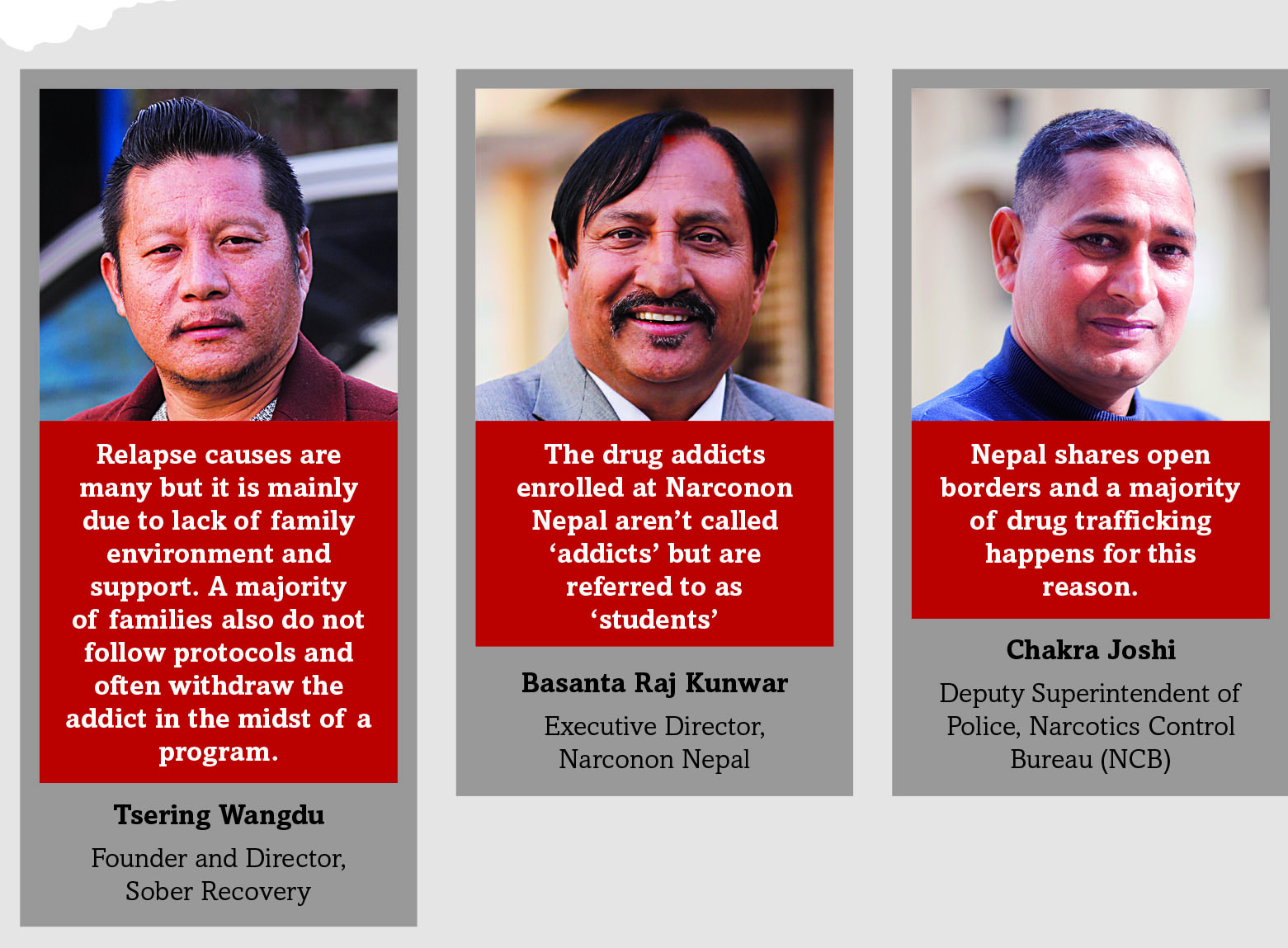
By Dibesh Dangol
The narcotic drugs scenario in Nepal may not be as pervasive as that in South America or Africa, but during the infamously known hippie period (60s-70s) in Nepal, drugs like marijuana and hashish were legal and openly sold in government licensed shops mainly in Jochhen, also known as Freak Street.
Joseph R Pietri, who was a former drug smuggler and is the writer of the book “The King of Nepal: Life before the Drug Wars”, has described his experience of the narcotics scenario in Nepal, especially Kathmandu, during this period in his book and mentioned how drug smugglers could easily go around Nepal to trade drugs like marijuana and hashish, along with other alarming subjects like drug wars and monarchs’ involvement in drug trades.
According to the statistics of drug abuse in Nepal from 2006 to 2012 provided by Deputy Superintendent of Police, Chakra Joshi, of Narcotics Control Bureau (NCB), there was 98% increment in the number of drug users (46,309 users in 2006 to 91,534 users) over the course of six years with an annual growth rate of 11.36%. In accordance with this statistic, 93% of the users were male and the rest were female, the highest proportion of users (57%) were injecting drugs directly and were mostly in the 20-24 age bracket.
He also shared the recent six years statistics of arrests and seizures from 2013 till August 2018, according to which 19,153 people were seized with possession of drugs or arrested of which 95.60% were Nepalis and the rest were foreigners. Of this 95.46% were males and the rest were females.
Relapse causes are many but it is mainly due to lack of family environment and support. A majority of families also do not follow protocols and often withdraw the addict in the midst of a program.
Tsering Wangdu Founder and Director, Sober Recovery
The drug addicts enrolled at Narconon Nepal aren’t called ‘addicts’ but are referred to as ‘students’
Basanta Raj Kunwar Executive Director, Narconon Nepal
Nepal shares open borders and a majority of drug trafficking happens for this reason.
Chakra Joshi Deputy Superintendent of Police, Narcotics Control Bureau (NCB)
[/su_column][/su_row]
In Nepal, Narcotic drugs are divided by NCB according to their production, trafficking and transit and abuse. As per DSP Joshi, narcotic drugs found and produced in Nepal are cannabis/marijuana (wild/illicit), hashish and raw opium; trafficked drugs are marijuana, hashish, heroin, pharmaceutical drugs and cocaine; and abused drugs are cannabis, hashish, controlled pharmaceutical drugs, hashish, heroin and amphetamine.
Beside these narcotic drugs, IAS Freedom Medal Winner 2013 Basanta Raj Kunwar who is the Executive Director of Narconon Nepal and a former Senior Superintendent of Police, focuses that though products containing alcohol are legalised, it is also a form of drug.
[su_pullquote align="right"]80% of drug addicts start taking drugs from the age of 14-19, and it is only after 7-10 years of abuse that the addicts come to rehabilitation centres for treatment.[/su_pullquote]
Though most people involved in narcotic drugs are aware of its negative impact, they still get pulled into it. The majority of drug users, mainly youths, have been found using drugs initially because of family problems or due to their friend circle. According to Kunwar,and Tsering Wangdu, Founder and Director of Sober Recovery, 80% of drug addicts start taking drugs from the age of 14-19, and it is only after 7-10 years of abuse that the addicts come to rehabilitation centres for treatment. As for alcoholics, Kunwar says that they come for rehab only after 14 years into addiction on average.
The survey report on current hard drug users in Nepal 2069 B.S reveals that about three fourth of users (70.1%) received drugs through drug user friends, whereas other sources of drugs are mobile drug sellers at 30.7%, medical stores at 28.4% and other reasons account for 30.2%.
Although the relapse cases after going into rehabilitation is a common event, there have been success stories too. Wangdu is one such case. He got involved in drugs, became drug free, and made a positive turn. Wangdu shares that he went down the dark path during school days, got involved in drugs for 15 years due to which people around him had to suffer. When realisation seeped in, he got into rehabilitation programs, became drug free, and did some voluntary work at a few rehabilitation centres which motivated him to establish Sober Recovery in 2009.
Later in 2012-2013, he saw that there were no rehabilitation centres working for females. The ones that existed had been closed, majority of rehabilitation centres were focused on males and females felt awkward joining male rehabilitation centres. So, he opened Sober Recovery Women in a separate location. Sober Recovery primarily uses Alcoholics Anonymous (AA) (also called Narcotics Anonymous (NA)) 12 Steps method which was initially made for alcoholics but later on was also used for the rehabilitation of narcotic drug addicts. Besides this, Sober Recovery also uses other methods depending on the cliens. The rehabilitation centre charges Rs. 25,000 per month for the treatment and the treatment can last uptil a year.
In 10 years, Sober Recovery has had 4000-5000 clients and has achieved 50% success rate. Wangdu states that relapse causes are many but it is mainly due to lack of family environment and support. A majority of families also do not follow protocols and often withdraw the addict in the midst of a program.
Kunwar took different approaches to cure drug addicts when he was associated with Nepal Police and during his initial days of retirement. But, he was not satisfied as 80% of cases went into relapse. Highly influenced by the treatment procedure developed by L. Ron Hubbard used by Narconon International, he applied for license of similar treatment and in 2004 he was granted the license.
“The drug addicts enrolled at Narconon Nepal aren’t called ‘addicts’ but are referred to as ‘students’,” informs Kunwar. The Narconon course includes four steps: Drug/Alcohol-Free Withdrawal, New Life Detoxification, Objectives Courses and Life Skill Courses. The course takes from 4-6 months to complete depending on the students and costs Rs. 5 lakhs for a whole course. Narconon Nepal has the capacity to accomodate 65 people and has more than 85% success rate.
Suresh Giri is one of the success stories of Narconon Nepal. Giri used to live in USA and though he was not a drug addict, he was an alcoholic. After he heard about Narconon Nepal, he applied and got enrolled into the program. Now, he is sober and works as a supervisor at Narconon Nepal.
When asked about legalisation of marijuana, DSP Joshi, Kunwar and Wangdu shared the same view. They all voice that marijuana shouldn’t be legalised for medicinal purposes or any other purposes because marijuana is the first step towards narcotic drugs. Instead, they said strict laws should be made for producers and traffickers of marijuana.
In DSP Joshi’s view, Nepal shares open borders and a majority of drug trafficking happens for this reason. He feels that the borders need to be tightly monitored, and if anybody has information about drug trade or production, they should immediately inform the police or NCB. As for the reduction in demand, he says the focus must be on awareness programs.
Today with rising consumerism, lack of opportunities for youth, stress, depression and behaviourial issues, more people are at risk of substance abuse. Young people share that party drugs, opiates, cocaine are readily available for those at risk, not just in seedy corners of bars and backstreets of Thamel but are also available at thriving high class establishments such as lounges and popular nightspots in the heart of the capital.



-1765706286.jpg)
-1765699753.jpg)

